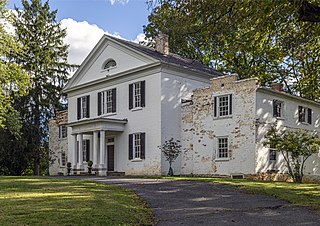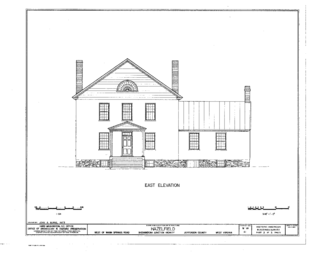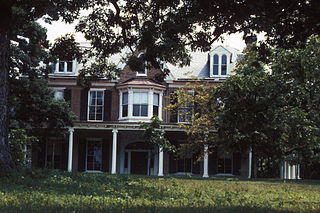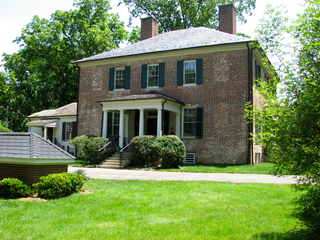Benjamin Franklin Washington was a relative of George Washington. He was involved in a duel with C. A. Washburn over articles printed in the San Francisco Herald.

Charles Washington was an American planter and politician who founded a town in the Shenandoah Valley that was named Charles Town in his honor shortly after his death and that of his eldest brother, George Washington.

Samuel Washington was an American planter, politician and military officer best known for being the younger brother of the first president of the United States, George Washington.

Happy Retreat is a historic property in Charles Town, West Virginia, which was originally owned and developed by Charles Washington, the youngest brother of George Washington and the founder of Charles Town.

Hazelfield, located near Shenandoah Junction, West Virginia is a historic farm, whose principal residence was built in 1815 for Ann Stephen Dandridge Hunter.

The Peter Burr House was built between 1751 and 1755 near present-day Shenandoah Junction, West Virginia, making it one of the oldest houses in West Virginia. Burr, whose first cousin was Aaron Burr, was one of the first settlers in the area. It is the oldest surviving post-and-beam-construction house in West Virginia. The 9.5-acre (3.8 ha) property was acquired from Burr family descendants in the 1990s and has been under restoration by Jefferson County Historic Landmarks Commission.

Blakeley, near Charles Town, West Virginia is also known as the Washington - Chew - Funkhouser House, and was built in 1820 by John Augustine Washington II, great-nephew of George Washington and grandson of John Augustine Washington. It is a contemporary of its neighbor, Claymont Court, built across Bullskin Run by John's brother, Bushrod Corbin Washington. John Washington did not attempt to match the grandeur of Claymont Court, as he was in line to inherit Mount Vernon, and did so in 1829.

Claymont Court, or simply Claymont, is a Georgian-style brick mansion, the grandest of several built near Charles Town, West Virginia for members of the Washington family. The current "Big House" was built in 1840 for Bushrod Corbin Washington, nephew of Supreme Court justice Bushrod Washington and grand-nephew of George Washington, to replace the 1820 main house on his plantation that burned in 1838.

Harewood is one of several houses in the vicinity of Charles Town, West Virginia built for members of the Washington family.

Altona, near Charles Town, West Virginia, is a historic farm with an extensive set of subsidiary buildings. The original Federal style plantation house was built in 1793 by Revolutionary War officer Abraham Davenport on land purchased from Charles Washington. The house was expanded by Abraham's son, Colonel Braxton Davenport. During the Civil War the farm was a favored encampment. Generals Philip Sheridan and Ulysses S. Grant both used the house as a headquarters and meeting place.

Beverley, also known as Bullskin, is a farm near Charles Town, West Virginia that has been a working agricultural unit since 1750. The narrow lane that leads from U.S. Route 340 to the Beverley complex was, in the 18th and 19th centuries a toll road. The main house was built about 1800 by Beverley Whiting on the site of a c. 1760 stone house. The house is Georgian influenced Federal style, with a later Greek Revival portico. A number of outbuildings dating to the original 1760 house accompany the main house.

Gap View Farm, near Charles Town, West Virginia, is a historic farm complex built in 1774. The farm was placed on the National Register of Historic Places on January 9, 1997.

Cool Spring Farm, located near Charles Town, West Virginia was first established along Bullskin Run around 1750. The Federal style second house on the property, built in 1813, is extant, with a Greek Revival–influenced third house, built in 1832 that shows the evolution of the farmstead. The farm is significant as an example of agricultural development in the Bullskin Run district and as examples of Greek Revival and Federal style vernacular design.

The Bower is an 1806 residence, originally built in the Federal style in Jefferson County, West Virginia, USA. It was later remodeled with Gothic Revival features after a fire in 1892. The name appeared as early as 1753 when Major General Adam Stephen had a hunting lodge at this location.
Barleywood is a farm in Jefferson County, West Virginia, on land once owned by Samuel Washington, brother of George Washington. The farm is close to Samuel's manor house, Harewood, from which the Barleywood property was subdivided in 1841. The Barleywood house was built in 1842, as well as several outbuildings which survive. The house sat vacant from the 1960s to the late 2010s and during that time it suffered from vandalism. It is now a private residence.
John Thornton Augustine Washington was a prominent Virginia farmer who served a term in the Virginia House of Delegates. Washington was a grandnephew of George Washington, first President of the United States.
Lawrence Berry Washington was an American lawyer, military officer, author, Forty-niner, border ruffian, and a member of the Washington family. Washington was born on his family's Cedar Lawn plantation near Charles Town, Virginia and was the eldest of 13 children. He practiced law, then served as a second lieutenant in the Virginia Volunteers during the Mexican–American War. During his service in the war, Washington reportedly wore the sword of his great-granduncle George Washington.

Fall Hill is a plantation located near the falls on the Rappahannock River in Fredericksburg, Virginia. Though the Thornton family has lived at Fall Hill since the early 18th century, the present house was built in 1790 for Francis Thornton V (1760–1836). The land on which Fall Hill is located is part of an 8,000 acres (3,200 ha) land patent obtained by Francis Thornton I (1657–1727) around 1720. The present-day town of Fredericksburg, Virginia is located on that original patent.
Bushrod Corbin Washington was a Virginia planter and politician, nephew of Supreme Court Justice Bushrod Washington, and grandfather of Confederate soldier and author Bushrod C. Washington (1839-1919) also discussed below.
William Augustine Washington was a Virginia planter and officer who served one term in the Virginia House of Delegates representing Westmoreland County, as well as terms as colonel of the county militia and as the county sheriff, before moving to the newly established District of Columbia. The son of the half-brother of President George Washington, he was also one of the seven executors of the former President's estate.


















